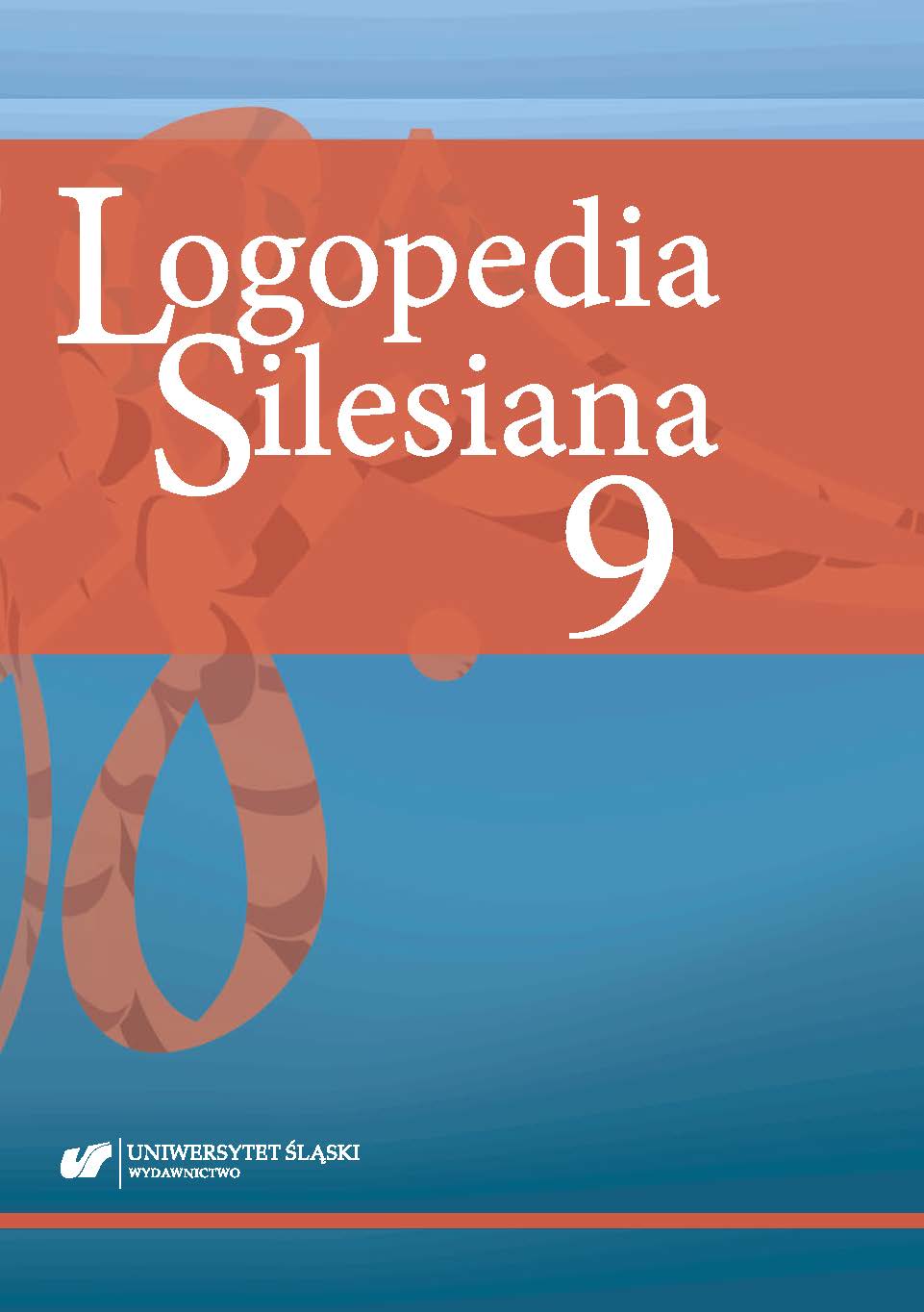Bandzul, K., Mrugacz, M. (2011). Zmiany w narządzie wzroku u pacjentów z mózgowym porażeniem dziecięcym. Neurologia Dziecięca, 20(40), 59–62.
Google Scholar
Boksa, E. (2014). Trudności w komunikowaniu się dzieci i młodzieży z mózgowym porażeniem dziecięcym w opinii specjalistów. W: A. Hamerlińska-Latecka, M. Karwowska (red.), Interdyscyplinarność w logopedii (s. 188–207). Gliwice: Komlogo.
Google Scholar
Boksa, E. (2015). Ocena zaburzeń połykania i komunikowania się u osób z mózgowym porażeniem dziecięcym cierpiących na dysfagię. W: M. Kurowska, E. Wolańska (red.), Metody i narzędzia diagnostyczne w logopedii (s. 228–236). Warszawa: Elipsa.
Google Scholar
Boksa, E. (2016a). Dysfagia z perspektywy zaburzeń komunikacji językowej u dzieci i młodzieży z niepełnosprawnościami sprzężonymi. Kraków: Libron.
Google Scholar
Boksa, E. (2016b). Ślinotok i zaburzenia komunikacji u pacjentów cierpiących na dysfagię. Studia Pragmalingwistyczne, 8, 271–282.
Google Scholar
Boksa, E. (2018). Perspektywy badań nad normą językową osób z niepełnosprawnościami sprzężonymi. W: P. Zbróg (red.), Wybrane aspekty badań nad normą językową (s. 212–231). Kraków: Libron.
Google Scholar
Bryant, D., i in. (2007). Ogólne podstawy i zasady interpretacji punktów końcowych ocenianych przez pacjenta. Polskie Archiwum Medycyny Wewnętrznej, 117(4), 125–131.
Google Scholar
Bujok, G., Tombarkiewcz, M. (2005). Jakość życia uwarunkowana stanem zdrowia jako nowy problem kliniczny. Wiadomości Lekarskie, 58(1–2), 67–70.
Google Scholar
Cockerill, H. (2011). Developing the Communication Function Classification System for individuals with cerebral palsy. Developmental Medicine and Child Neurology, 53(8), 675–676.
Google Scholar
Gajewska, E. (2009). Nowe definicje i skale funkcjonalne stosowane w mózgowym porażeniu dziecięcym. Neurologia Dziecięca, 18(35), 67–71.
Google Scholar
Grabias, S. (2005). Interakcja językowa i jej uwarunkowania. Perspektywa lingwistyczna. W: J. Bartmiński, U. Majer-Baranowska (red.), Bariery i pomosty w komunikacji językowej Polaków (s. 19–44). Lublin: Wydawnictwo Uniwersytetu Marii Curie-Skłodowskiej.
Google Scholar
Hidecker, M.J.C., Paneth, N., Rosenbaum, P. (2009). Development of the Communication Function Classification System for individuals with cerebral palsy. Poster presented at American Academy for Cerebral Palsy and Developmental Medicine. Conference. Arizona.
Google Scholar
Kaczorowska-Bray, K., Brzozowska-Misiewicz, I. (2012). Niepełnosprawność intelektualna jako zaburzenie mogące współwystępować z innymi zespołami. W: J. Błeszyński, K. Kaczorowska-Bray (red.), Diagnoza i terapia logopedyczna osób z niepełnosprawnością intelektualną (s. 130–146). Gdańsk: Harmonia Universalis.
Google Scholar
KIDSCREEN Group (2004). KIDSCREEN-52. Kwestionariusz zdrowotny dla dzieci i młodzieży. Wersja dla rodziców. file:///C:/Users/Start/AppData/Local/Temp/KIDSCREEN-52_parents_Poland.pdf [data dostępu: 1.01.2011].
Google Scholar
Mazur, J. (2004). Budowa i wstępna analiza psychometryczna polskiej wersji kwestionariusza do badania jakości życia dzieci i młodzieży (KIDSCREEN-52). Medycyna Wieku Rozwojowego, 3, 513–533.
Google Scholar
Michalska, A. (2013). Trudności w jedzeniu i komunikowaniu się dzieci i młodzieży z mózgowym porażeniem dziecięcym w opinii rodziców. W: E. Boksa, A. Michalska, P. Zbróg (red.), Aktualne problemy diagnozy i terapii osób z niepełnosprawnościami sprzężonymi i zaburzeniami rozwojowymi (s. 223–238). Kraków: Libron.
Google Scholar
Michalik, M. (2015). Mózgowe porażenie w teorii i praktyce logopedycznej. Gdańsk: Harmonia Universalis.
Google Scholar
Michalska, A., Boksa, E., Wendorff, J., Wiktor P.J. (2012a). Jakość życia dzieci i młodzieży z mózgowym porażeniem dziecięcym i niepełnosprawnością intelektualną. Wybrane uwarunkowania społeczno-demograficzne. Neurologia Dziecięca, 21(42), 35–44.
Google Scholar
Michalska, A., Wendorff, J., Boksa, E., Wiktor, P.J. (2012b). Jakość życia dzieci i młodzieży z mózgowym porażeniem dziecięcym i niepełnosprawnością intelektualną. Rodzinne uwarunkowania społeczno-demograficzne. Neurologia Dziecięca, 21(43), 49–58.
Google Scholar
Michalska, A., Wendorff, J., Boksa, E., Wiktor, P.J. (2012c). Jakość życia dzieci i młodzieży z mózgowym porażeniem dziecięcym i niepełnosprawnością intelektualną. Wybrane uwarunkowania kliniczne. Neurologia Dziecięca, 21(43), 39–48.
Google Scholar
Michałowicz, R. (2001). Mózgowe porażenie dziecięce. Warszawa: Wydawnictwo Lekarskie PZWL.
Google Scholar
Ostrzyżek, A. (2008). Jakość życia w chorobach przewlekłych. Problemy Higieny i Epidemiologii, 89(4), 467–470.
Google Scholar
Pakula, A.T., Van Naarden Braun, K., Yeargin-Allsopp, M. (2009). Cerebral palsy: classification and epidemiology. Physical Medicine and Rehabilitation Clinics of North America, 20, 425–452.
Google Scholar
Papuć, E. (2011). Jakość życia – definicje i sposoby jej ujmowania. Current Problems of Psychiatry, 12(2), 141–145.
Google Scholar
Pirpiris, M.,i in. (2006). Function and well-being in ambulatory children with cerebral palsy. Journal of Pediatric Orthopaedics, 26(1), 119–124.
Google Scholar
Reddihough, D.S., Collins, K.J. (2003). The epidemiology and causes of cerebral palsy. Australian Journal of Physiotherapy, 49(1), 7–12.
Google Scholar
Rosenbaum, P., i in. (2007). A report: the definition and classification of cerebral palsy. Developmental Medicine and Child Neurology, 109, 8–14.
Google Scholar
Shelly, A., i in. (2008). The relationship between quality of life and functioning for children with cerebral palsy. Developmental Medicine and Child Neurology, 50(3), 199–203.
Google Scholar
Surveillance of Cerebral Palsy in Europe. (2002). Prevalence and characteristics of children with cerebral palsy in Europe. Developmental Medicine and Child Neurology, 44(9), 633–640.
Google Scholar
Topór, E., Kułak, W. (2010). Jakość życia dzieci z mózgowym porażeniem dziecięcym. Neurologia Dziecięca, 9(37), 61–66.
Google Scholar
Varni, J.W., i in. (2006). The PedsQL in pediatric cerebral palsy: reliability, validity, and sensitivity of the Generic Core Scales and Cerebral Palsy Module. Developmental Medicine and Child Neurology, 48, 442–449.
Google Scholar
Zgorzalewicz, B., Miszczanek, T., Zgorzalewicz, M. (2001). Epidemiologia opisowa mózgowego porażenia dziecięcego. Ortopedia, Traumatologia, Rehabilitacja, 3(4), 267–471.
Google Scholar


 https://doi.org/10.31261/LOGOPEDIASILESIANA.2020.09.10
https://doi.org/10.31261/LOGOPEDIASILESIANA.2020.09.10

 10.31261/LOGOPEDIASILESIANA
10.31261/LOGOPEDIASILESIANA